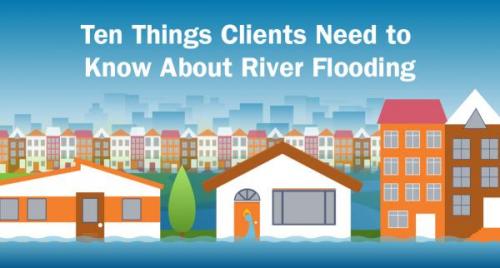From snowmelt to severe storms, flooding is the new normal as weather gets warmer after winter. That’s especially true for communities along rivers and streams. Yet, every spring, too many communities are unprepared.
Help Clients Understand Their Risks—and the Benefits of Flood Insurance
Changing weather patterns increase the risks of flooding, so it’s important to build community resilience through awareness.
As an insurance agent, you’re a trusted advisor. You can help families and businesses understand their flood risk and options for financial protection.
Use these talking points to help your clients protect the lives they’ve built.
FloodSmart Talking Points
- You don’t have to be near a coast, river or stream to face flood risk. Anywhere it can rain, it can flood. And spring brings some unique flood risks.
- As frozen rivers and streams start melting, ice jams can cause rivers to overflow upstream. When a jam breaks free, it may cause flash flooding downstream.
- Heavy spring rains and melting snow increase the likelihood of rivers overflowing and of more severe river flooding. Heavy river flooding can cause damage miles away from the river itself.
- Warmer temperatures often bring slow-moving storms that carry more water. Prolonged, heavy rain increases flood risk.
- Just one inch of floodwater in a typical home can cause up to $25,000 of damage.
- Most homeowners, renters and business insurance don’t cover flood damage.
- New flood insurance policies usually take 30 days to go into effect, which makes it important to get coverage before flooding is predicted.
- Disaster assistance may not cover your flood losses:
- Federal assistance is available only when the President declares a major disaster.
- Most assistance is in the form of loans that must be repaid with interest.
- Disaster grants provide far less financial assistance than flood insurance.
- Second homes are not eligible for disaster assistance.
- Flood insurance is the best way to protect against the financial impacts of flooding.
- You can prepare to help reduce flood losses:
- Store copies of important documents, records and insurance papers in a safe, dry place. Keep originals in a safe deposit box.
- Elevate and anchor utilities: electrical panels, propane tanks, appliances and heating systems.
- Toss or clear debris from gutters and downspouts to avoid backups.
- Learn more at floodsmart.gov/SET
Supercharge Your Resources
Get more information to share with your clients and help boost sales.
• River Flooding Landing Page
• Agent Webinar
Keep current on flood insurance. Follow the NFIP on LinkedIn for updated content daily.

